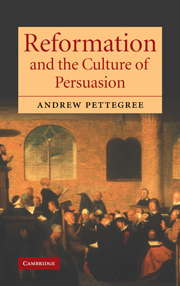5 - The visual image
Published online by Cambridge University Press: 04 December 2009
Summary
With preaching, music and drama we have investigated three different aspects of the collective culture of sixteenth-century society. Clearly the three impacted on the consciousness of the Christian people in different ways; whereas dramatic performances were occasional, special events in most contexts, by the second generation of the Reformation Protestant peoples would have heard sermons very regularly. Singing, meanwhile, was an engrained part of both their public worship culture and their private entertainments.
All helped ensure that the challenge of the new evangelical movement would touch all members of society, both those who had access to the new Protestant teachings through reading – the literate – and those who had not. That there should be no gulf in understanding between these two groups was of course a huge concern to contemporary churchmen, aware as they were of the bookish and cerebral tendency of the theological debate inspired by Luther, and the difficulties of teaching even the barest essentials of the new Christian principles to the population at large: a concern to which the great outpouring of pedagogic literature inspired by the Reformation bears eloquent testimony.
The question of how cognizance of the new Christian teachings could be inculcated among the broad mass of the population is also one that has preoccupied historians, though the context of the discussion has been rather different from that proposed in the first half of this book.
- Type
- Chapter
- Information
- Reformation and the Culture of Persuasion , pp. 102 - 127Publisher: Cambridge University PressPrint publication year: 2005
- 1
- Cited by

